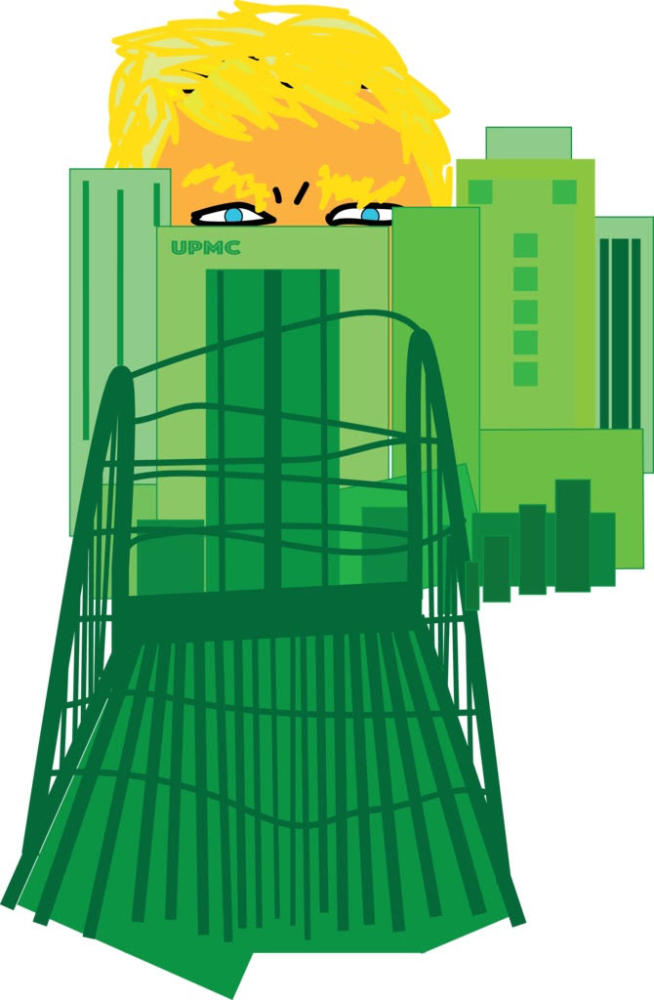

(Amanda Nichols | Staff Illustrator)
When President Donald Trump decided to pull out of the Paris climate agreements, he said that he was elected to represent the people of Pittsburgh, not Paris — a statement that was met with fiery outlash from important figures such as Mayor Bill Peduto, who said that Pittsburgh will in fact continue to abide by the Paris agreements.
Peduto’s commitment to fighting climate change in Pittsburgh may have shocked many who don’t live here. Pennsylvania’s media presence seems to focus on its coal mines, farmland murders or poor air quality.
But things like these — murders aside — are merely evidence of the city’s historically crucial role to the American industrial economy. Today, Pittsburgh is at the forefront of fighting climate change, visible everywhere from Pitt’s campus to some of Downtown’s most iconic buildings.
But when I arrived in Pittsburgh as a first-year student, my impressions aligned with those others had impressed upon me. Simply, I noticed Oakland’s garbage. Cans littered the streets on Saturday mornings, the racket of Fifth Avenue filled the air with grease and gasoline and evidence of the city’s history of steel was still present in the Cathedral’s preserved sooty section, showing how polluted the air once was.
This grit, even more evident farther from the city center in places like Braddock, Somerset and New Kensington, isn’t blameworthy though. It was merely adaptation to an era, an era that people like Trump think Pittsburgh is still in.
The places where Pittsburgh shines revealed themselves to me slowly, but without much effort. All it took was me hopping on my trusty bicycle for a ride downtown.
I started on Bates Avenue and soon found myself on a bike trail that led me to Point State Park, a triangular convergence of the Ohio, Allegheny and Monongahela rivers. The park served as a hub for transportation and industry throughout the 1900s long after it served as a crucial strategic fort — Fort Pitt — where many campaigns began during the Revolutionary War.
Clearly, Trump hasn’t been to Point State Park, and the last photos he saw of it might’ve been from the 1940s or ‘50s, when it was still littered with warehouses and freight yards. The park was designated a National Historic Landmark in 1975 and renovated. Today the Point, as Pittsburghers affectionately call it, is home to some of the city’s largest cultural events and is teeming with activity. But it doesn’t always draw visitors into the city — the Point also serves as the western terminal of the Great Allegheny Passage, a nearly 150-mile bicycle and walking trail connecting Pittsburgh with Washington, D.C.
But I chose to go downtown, riding past buildings like the David Lawrence Convention Center, a sprawling, beautiful building that was the largest green building in the world when it opened. Others like it include the new Energy Innovation Center at the edge of the Hill District, home to Pitt’s laboratories that rake in numerous, well-respected awards.
Soon, I realized that I didn’t have to go all the way to Downtown to find innovative projects and beautiful landscapes. Pittsburgh’s sprawling neighborhoods, each with their own unique personality, all are homes to beauty. Here in Oakland, places like Phipps Conservatory show our neighborhood’s commitment to empowering every generation with the knowledge necessary to live and succeed in a global world that is concerned with the environment. Phipps recently completed construction of its SEED Classroom. Only the second of its kind, this modular classroom generates its own energy, recycles water on site and even is home to an observational beehive, educating children and adults alike about the importance of living sustainably.
My perception of Pittsburgh quickly flipped on its head — I arrived believing the myths that Pittsburgh was a dirty coal and steel city still or that you couldn’t swim in the rivers. But I kept an open mind and remembered to keep my eyes open. Our city is rapidly changing, and has been for quite some time.
Maybe our president doesn’t notice that, or maybe he’s choosing to ignore it and trying to force Pittsburgh back into the mold of old industrial success. But I now know that Pittsburgh, with all its dirty history, is a city that’s proud to uphold the Paris climate agreements, and a city that will continue to lead our nation in a more sustainable direction.
Recent Posts
Therese Pitman: Giving back to Pitt’s student-athletes with equality
Pitman is Pitt’s Director of Student Athlete Development where she helps student-athletes navigate their career…
Pitt speech and debate team heads to nationals
The William Pitt Debating Union, Pitt’s speech and debate team, sends students to both in-person…
Visuals: A Year in Review
The visuals desk had an interesting year. In the midst of the 2024 Presidential Election,…
De-stress events across campus offer students a break from studying
During finals week, departments across campus are offering wellness events to help students manage stress…
Pitt students share their summer plans
After a long and strenuous academic year, many students are excited to take a break.…
Column | Collaboration and connection make us better — yes, even in journalism
Today is the last day I will ever do this, and despite the amount of…